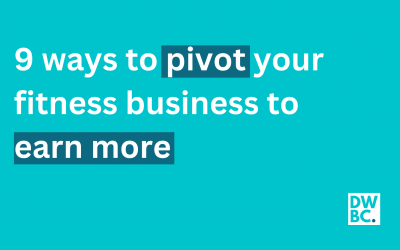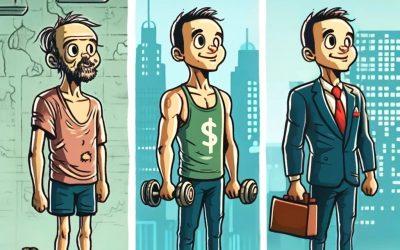TL;DR
- Combining fitness models creates unique, competitive advantages.
- Hybrid models offer maximal upside with minimal downside.
- Eight novel fitness business combinations identified.
- Divergent thinking can spark unique, successful business ideas.
What if we could combine fitness business models to get all the upside, with none of the downside. Let’s talk about what that would look like.
There’s one approach to business that works every time.
Be the best at something. Be so good they can’t ignore you.
But it’s very hard to be the best in the world at something.
There’s only one room for one person on top of the podium.
It’s actually much easier to be the best on earth at TWO things. But that sounds confusing and counterintuitive, so let’s explore that idea a little deeper.
Overlapping Strengths
Let’s say you’re a hairdresser. You’re pretty good, but you’re not the best.
In your spare time, you make cupcakes for kids birthdays. The cupcakes are nice, but they’re not the best.
So you’re pretty good at two things. On the left, I want you to picture a circle that contains all the hairdressers. On the right, a circle with all the bakers. Let’s start moving these circles closer to each other, until they overlap. In that thin slither of overlap, there’s only one person. You. A pretty good hairdresser, who’s also a pretty good baker.
But now, instead of just being pretty good at two things, you’re the best at one thing – being a hairdresser who serves up a custom cupcake to your clients as they walk into your salon.
You start a business called Cuts and Cakes. It goes viral on Instagram. You’ve created your own category. It’s a category of one. You’re the only business in it. You’ve got no competition. You’re now the best in the world.
The Five Fitness Business Models
What if we ran this same thought experiment on the fitness industry. In the last episode of The Business of Fitness Podcast, I did a deep dive into the five most common fitness business models, Personal Training, Open Gym Memberships, Semi Private, Classes and Online Coaching.
I ranked these across 12 different categories, including profit, purpose and impact. If you haven’t checked out that episode, I highly suggest you go and have a listen – there are some surprising and very actionable findings.
A big takeaway from my analysis of the five business models was that there was no perfect model that scored highly in each category. Personal Training rated highly in profit margin, but low in culture and community. Open Gym Memberships lead the field in scaleability, but bottomed out for retention. Semi Private training scored 8/10 for required volume of clients, but has high start-up costs. Classes are great for culture, but terrible for time freedom. While online training is amazing for time freedom, but scores a 2/10 for culture and community.
Every time a business model scores high on something, it scores low on something else.
There’s always a compromise.
Combining Business Models
But it got me thinking. Does there always have to be a compromise? Can we combine business models to get the best bits of each? Just like we did with the hairdresser and their business ‘Cuts and Cakes’, is it possible to overlap business models to create whole new categories where innovation is high, competition is low and success is almost guaranteed. We see this all the time in business, where co-founders each have their own strengths which cancel out their partner’s weaknesses. Just look at Apple – Steve Jobs was the visionary, while his co-founder, Steve Wozniak was the engineer. Without their combined skillset, Apple would never have made it out of Jobs’ garage – just like a lot of Fitness Businesses who follow a traditional business model never make it out of the daily grind.
So I set out to combine these business models in weird and wonderful ways. What would Willy Wonka do?
Before we get into the overlaps, and the potential new business ideas they bring, a couple of thoughts.
Some of these ideas are already being implemented (and I’ll talk about some of the more famous examples), while some are highly novel and unique. There are 25 different combinations we can make, and I think that eight of these have potential. Some are terrible ideas that I won’t bother exploring, but if I think there’s potential, I’ll share it with you. My hope is that this out-of-the-box divergent way of thinking can spark some creative and unique ideas of your own. Where possible, I’ll focus on the ideas that cancel out each other’s weaknesses. I’m looking for maximal upside, with minimal downside.
New Categories
And I don’t just want to combine business models to run next to each other, I actually want to create new categories. For example, Open Gym and Personal Training can run side by side within the same facility, but they’re still two different models. And Personal Training and Online Programming are commonly used together in what we seem to be calling a ‘hybrid model’ – but like water and oil, they’re still not really mixed. I want to create new models, the love child of what we already have. After I did this research, I asked ChatGPT to combine the models to see if it could come up with anything I’d missed – and all I got were versions of the hybrid model – existing services running side-by-side. Combining ideas to create original thought seems to still be just beyond the grasp of AI.
I’ll be the first to admit, some of these ideas have some pretty big holes in them, but they’re all possible, and they’re guaranteed to make you think.
Let’s go rapid fire, here are the 8 best ideas that come at the intersection of the traditional fitness business models.
Personal Training + Semi Private
These are two business models that scored highly in my review of profit margin, and when combined this can have a multiplier effect. Maybe you charge $120 for an hour of PT, one-on-one. In semi private, maybe you charge five people $30 each, upping your hourly rate from $120 to $150. Combine the two however, and focus on one-on-two training, and you could charge each person $90 for an hour – upping your hourly rate to $180. Retention and attendance will also be higher with the built in accountability boost. Start up costs will also be much less than for semi-private as you can operate using a similar rent model as a PT. Scaleability also doubles, as you’re effectively doubling your capacity.
Personal Training + Classes
Imagine a class, where instead of one instructor to each attendee, each attendee has their own coach. Picture a group of 12 people, following the same programming in the same group environment, with the same vibe. But each person has their own ‘guide’ to help them get the most out of their workout. Now in your head you’re probably already poking holes in this model, and you won’t be alone – I can see a lot of problems with it. But if you’re discounting it, other people probably are too, meaning if you give it a go, you’ll be the only person in your own category. Whether this idea has potential or not, it’s unique food for thought, and that’s what I’m trying to give you here.
Personal Training + Online Coaching
This is something I’ve done on and off over the last decade – long before COVID made it cool. Geography has always been a barrier to Personal Training. If a client moved away, they stopped training with you. But there’s no reason you can’t run PT over a video call, either with the client at home, or at their local gym. It brings its own set of challenges, but I’ve trained people interstate and overseas with a lot of success. It gives all the financial benefits of Personal Training, with the added geographic freedom of online coaching. It can also help to boost the low client progression score that online coaching alone has. During COVID, we were running around 600 one-on-one online PT sessions per month at Range of Motion, and saw no drop in income in spite of lockdowns and mandates.
Personal Training + Open Gym memberships
This is a tricky combination, as these are at different ends of the ‘contact spectrum’. For the client, the benefit of Personal Training is that it’s individualised, and the benefit of a gym membership is that it allows you to exercise whenever it’s convenient for you. What if we could combine these? There are a lot of people who don’t avoid PT because of the cost, but because regularly scheduled appointments just don’t fit into their dynamic calendar. What if you could have a facility where clients paid a ‘retainer’ to enable them to rock up at any time, and there’ll be someone there to train them. This would be a premium service – but the people who need this can probably afford a premium service. Again, you’re probably thinking ‘this wouldn’t work’. But switch your thinking to ‘how COULD I make this work’. While everyone else is zigging, you should zag.
Open Gym memberships + Semi Private, and this also applies to Open Gym memberships + Classes
Similar to the combination of PT and open gyms, maybe we could play with the ‘time variable’ here. Instead of locking into a 6am-7am semi private session, maybe there could be a time range when a coach is on duty. Maybe from 5am to 8am that coach is available to work closely with anyone who attends – working the room to give focussed one-on-one attention to people when they need it most. They could run impromptu mini-lectures on certain topics that are relevant to the people in attendance, where the group comes together to learn or refine technique, then breaks off again to return to their session. Another idea is to provide programming that explicitly requires cooperation. Group workouts where teams of three work together to get the session done, but they can come in and do the session at any time. You’ll get friends coming in together to train – holding each other accountable and having a lot of fun along the way. With this combo, required membership volume goes down, while purpose, culture, client progress and income go up.
Open Gym memberships + Online Coaching
Here’s a good way for price sensitive clients to get a high level of individualisation, service and experience. We’re combining two services with a traditionally low price point, but two that also rate very highly on time freedom for the Fitness Professional. What about an open gym model, where people come in only to do their individualised online programming (which you have highly systemised to ensure it’s scaleable and time efficient for you). This model works well for elite training facilities and institutes of sport, but there’s no reason why it can’t work well for a more general population. This is a model I’ve played with at Range of Motion over the last 18 years, but have combined it with Personal Coaching. Each clients gets an individualised program based on a browser based piece of software we built over five years. This software allows us to systemise the individualisation of programming using algorithms that bias programming based on a series of data points. Clients then come in to our facility to train and follow their program on their own. Every client has their own Personal Coach who they train one-on-one with at least once a week. We’ve had a team of 12 staff administering this model with almost 200 clients. It can be very successful.
Online Coaching + Classes, with a lot of these ideas also applying to Online Coaching + Semi Private.
We’ve seen this done during COVID. Then lockdowns went away and this business model went away. And for good reason… it sucked. Video classes lacked all the benefits that make in-person classes unique. But that’s because we were approaching them the wrong way. Just like in the early days of television, when content creators (coming from a radio background) initially relied on reading radio scripts on TV, not yet fully utilising the visual potential of the new medium. This is what happened during COVID – we weren’t utilising the new medium. Since then, online classes like Peloton have proven this model can work. Ironically, we’ve gone full circle. I remember aerobics classes on TV before the cartoons started on Saturday morning. Makes me wonder, how many ideas are actually new, and how many are simply recycled from the past?
Semi Private + Classes
Picture this. A class of 20 people – with all the vibe, energy and social benefits a class brings. But within that class, there are smaller ‘pods’ of five people, each with their own coach. Pods can be broken up into level of fitness, friendship groups, different ‘factions’ to create competition, or by any other method. Pods can come together for group warm-ups or cool downs, an then seperate for ‘break out’ sessions for the different elements of the program. On the topic of programming – you don’t need 20 rowers for a class of 20. You just need five, because only one pod will be using them at a time – so set up costs come down. It justifies a much higher price point than a class alone, and gives a lot of the cultural benefits of classes with the higher degrees of purpose and progression that semi private training brings. Retention and attendance will be higher as you can’t hide in a pod of five like you can in a class of 20.
So those are the intersections.
Sparking New Ideas
Maybe you didn’t like any of my ideas. And that’s ok. I wasn’t trying to give you an idea, I was trying to encourage you to think divergently and maybe nudge you in the direction of sparking an original idea of your own.
If you follow one of these ideas already, I’d love to hear from you – it’s always great to chat with original thinkers. And if you think one of these ideas has legs, reach out too – it’d be great to throw around some thoughts.
The big take away is a phrase I’ve already used. When everyone else is zigging, you need to zag. The industry is drowning in the status quo. Boring, repetitive, predictable carbon copies of each other. Shades of grey. How can you add some colour to differentiate yourself? How can you create your own category where’s there’s no competition because you’re the only person in it?
What’s your big idea?





